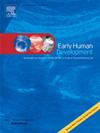The effect of maternal fatigue on the risk of fetal growth retardation
IF 2.2
3区 医学
Q2 OBSTETRICS & GYNECOLOGY
引用次数: 0
Abstract
Objectives
The purpose of this study is to investigate the influence of fatigue trajectories on fetal growth during pregnancy.
Methods
Pregnant women and their fetuses were recruited at 11–13 weeks of gestation. Fatigue was assessed using the Chalder Fatigue Scale. Fetal growth was monitored through three ultrasound examinations. Growth Mixture Models characterized fatigue trajectories during pregnancy, while Generalized Estimating Equations analyzed the relationship between fatigue and fetal growth. Latent Growth Curve Models further explored how changes in fatigue and fetal growth affected their trajectories.
Results
The analysis included 782 pregnant women. The GEEs revealed significant differences in fetal growth metrics—BPD, AC, and FL, across four groups based on fatigue trajectory (P total < 0.001). Compared to the non-fatigued group, the persistent fatigue group showed significantly lower BPD (β = 0.067, 95 % CI 0.021–0.220 P < 0.001), AC (β < 0.001, 95 % CI 1.432E−08–0.001; P < 0.001), and FL (β = 0.073, 95 % CI 0.027–0.196; P < 0.001), next was the early fatigue group. Parallel process LGCM results showed that higher initial levels of maternal fatigue during pregnancy were associated with lower baseline BPD (r = −0.062, P = 0.022), AC (r = −0.147, P = 0.030), and FL (r = −0.458, P = 0.004) measurements. In addition, we observed that the change in the slope of maternal fatigue also affected the change in the AC measurements (β = −0.917, P = 0.015).
Conclusion
Maternal fatigue during pregnancy impacts fetal growth. Initial levels of fatigue predicted the trajectory of fetal growth changes, and the slope of change in fatigue simultaneously affected the slope of change of infant growth, highlighting the importance of comprehensive management and intervention for excessive fatigue.
产妇疲劳对胎儿发育迟缓风险的影响
目的探讨孕期疲劳运动轨迹对胎儿生长发育的影响。方法选取妊娠11 ~ 13周的孕妇及其胎儿。使用Chalder疲劳量表评估疲劳程度。通过三次超声检查监测胎儿生长情况。生长混合模型描述了妊娠期间的疲劳轨迹,而广义估计方程分析了疲劳与胎儿生长的关系。潜在生长曲线模型进一步探讨了疲劳和胎儿生长的变化如何影响其轨迹。结果共纳入782名孕妇。GEEs显示,基于疲劳轨迹,四组胎儿生长指标bpd、AC和FL存在显著差异(P total <;0.001)。与非疲劳组相比,持续性疲劳组BPD显著降低(β = 0.067, 95% CI 0.021-0.220 P <;0.001), AC (β <;0.001, 95% ci 1.432e - 08-0.001;P & lt;0.001), FL (β = 0.073, 95% CI 0.027-0.196;P & lt;0.001),其次是早期疲劳组。平行过程LGCM结果显示,怀孕期间较高的初始产妇疲劳水平与较低的基线BPD (r = - 0.062, P = 0.022)、AC (r = - 0.147, P = 0.030)和FL (r = - 0.458, P = 0.004)测量值相关。此外,我们观察到产妇疲劳斜率的变化也会影响AC测量值的变化(β = - 0.917, P = 0.015)。结论孕期产妇疲劳会影响胎儿的生长发育。初始疲劳水平预测了胎儿生长变化的轨迹,疲劳变化的斜率同时影响了婴儿生长变化的斜率,突出了过度疲劳综合管理和干预的重要性。
本文章由计算机程序翻译,如有差异,请以英文原文为准。
求助全文
约1分钟内获得全文
求助全文
来源期刊

Early human development
医学-妇产科学
CiteScore
4.40
自引率
4.00%
发文量
100
审稿时长
46 days
期刊介绍:
Established as an authoritative, highly cited voice on early human development, Early Human Development provides a unique opportunity for researchers and clinicians to bridge the communication gap between disciplines. Creating a forum for the productive exchange of ideas concerning early human growth and development, the journal publishes original research and clinical papers with particular emphasis on the continuum between fetal life and the perinatal period; aspects of postnatal growth influenced by early events; and the safeguarding of the quality of human survival.
The first comprehensive and interdisciplinary journal in this area of growing importance, Early Human Development offers pertinent contributions to the following subject areas:
Fetology; perinatology; pediatrics; growth and development; obstetrics; reproduction and fertility; epidemiology; behavioural sciences; nutrition and metabolism; teratology; neurology; brain biology; developmental psychology and screening.
 求助内容:
求助内容: 应助结果提醒方式:
应助结果提醒方式:


